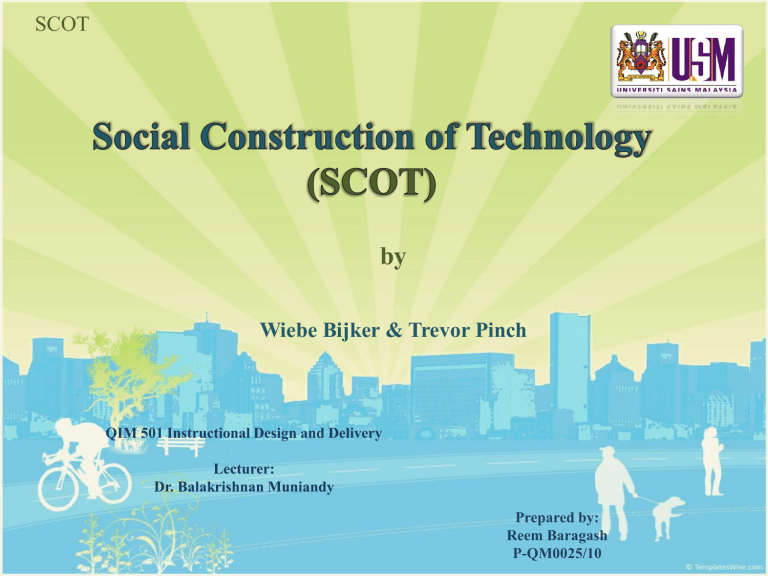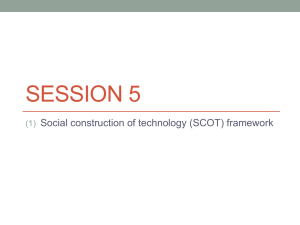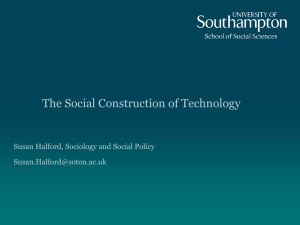SCOT - Instructional Design & delivery / 2010 + Research methods

SCOT by
Wiebe Bijker & Trevor Pinch
QIM 501 Instructional Design and Delivery
Lecturer:
Dr. Balakrishnan Muniandy
Prepared by:
Reem Baragash
P-QM0025/10
SCOT
1
Author:
w.bijker@maastrichtuniversity.nl
Prof.Dr.Ir. Wiebe E. Bijker
A Dutch professor of Technology & Society at the University of Maastricht
•
Wiebe E. Bijker (1951) was educated as an engineer (physics) at Delft
University of Technology
• then studied philosophy of science at the Universities of Amsterdam and
Groningen
• received a PhD in the history and sociology of technology from Twente
University.
•
He was active in the ‘science, technology and society’ (STS) movement, and helped to translate its insights into secondary school science teaching.
•
Bijker held a variety of administrative offices in Maastricht University, nationally, and internationally.
•
Internationally his Presidency of the Society for Social Studies of Science and various roles in the Society for the History of Technology stand out.
•
Bijker’s research focuses on the relation between technology, society, and science. Since the 1990’s political and normative issues have been central in
Bijker’s research.
•
In 2006 Bijker received the John Desmond Bernal Prize, awarded jointly by the
Society for Social Studies of Science and the Thomson Scientific, for his distinguished contribution to the field of science and technology studies.
•
In 2009 he was appointed Officier in de Orde van Oranje Nassau.
SCOT
2 tjp2@cornell.edu
Author:
Trevor Pinch
A sociologist and former chair of the Science and Technology
Studies department at Cornell University
(born: 1952)
• 1973 B.Sc., Physics (Imperial College, London University)
•
1976 M.Sc., Liberal Studies of Science (University of Manchester)
•
1982 Ph.D., Sociology (University of Bath)
Academic
•
1994-1999 Professor, Cornell University, Department of Sociology and of Science and Technology Studies
•
1990-1994 Associate Professor, Cornell University, Department of Science and
Technology Studies
•
1990-1991 Senior Lecturer in Sociology, University of York
•
1987-1990 Assistant Director, Institute for Research in the Social Sciences,
University of York
• 1985-1990 Lecturer in Sociology, University of York
•
1983-1985 Temporary Lecturer in Sociology, University of York
•
1980-1982 Research Fellow, School of Humanities and Social Sciences, University of Bath
• 1975-1977 Research Officer, School of Humanities and Social Sciences, University of Bath
SCOT
SCOT
Social Construction of Technology or
How the Sociology of Science and Sociology of Technology might Benefit each other
SCOT
Introduction:
- is a constructivist model of technological innovation.
- is often contrasted with the theory of technological determinism
- inspired by the sociology of scientific knowledge (SSK), and in particular by SSK's principle of symmetry.
SSK holds that successful theories do not succeed because they are "true,“ but rather because they are socially supported.
SCOT
Introduction:
Similarly, SCOT holds that:
successful innovations cannot be explained by assuming that they "work“ better than failed innovations.
the analyst must undercover the social context that promotes (or fails to promote) a given innovation.
SCOT established a new way to examine the social context of technological innovation.
SCOT
Bicycle’s case..
Pinch and Bijker’s study the case of the bicycles, they analyze the development of the bicycle.
SCOT
Boneshaker
Macmillan bicycle
Gulimet’s bicycle
Penny farthing xtreaordenary
Geared
Facile star
Club safety
Lawns bicyclette
This the linear view of development process of the “Penny farthing”
Solid line indicate to successful development, and dashed line indicate failed development
It didn’t take some safety ordinaries seriously.
Some safety ordinaries like “Lawson’s Bicyclette” play an important role in this model was fail commercially.
SCOT
In contrast with the linear model , a multidirectional view is essential to any social constructive account of technology.
SCOT
Boneshaker
Macmillan bicycle
Here we can see the artifact
(penny farthing) and a range of possible variation.
Gulimet’s bicycle
Penny farthing xtreaordenar y star
Geared
Facile Lawns bicyclette
Kangaroo
Club safety
A Multidirectional view Of the developmental process of the “Penny Farthing” bicycle
SCOT
Possible Question
Why some of variants “die” whereas others “survive” ??
To illuminate this selection part of the developmental processes, let’s consider the problems and solutions presented by each artifact at particular moments.
Problems :
-In deciding which problems are relevant, the social group concerned with artifact and the meaning that those groups give to the artifact play an essential role .
- A problem is defined as such only when there is a social group found a “ problem ”
SCOT
Social Group
• Variation of groups called relevant social group competing to control a the artifact.
• Different relevant
Social groups have problems with artifact
• Various solutions to solve the problems.
•
Some solutions become more widely accepted than others. problem problem
Social Group problem
Solution
Artifact problem
Social Group
Social Group
Solution
Artifact
Solution
Artifact
Solution
Artifact
Social Group
Social Group
Social Group
Social Group
SCOT
Dress problem producers
Sport cyclists
Penny
Farthing problem
Tourist cyclists problem problem problem problem
Safety problem
Solution
Artifact
Lower fron wheel
Social Group
Fron forl stoping back
Social Group
Artifact
Social Group
Social Group
SCOT
Core Concepts
1.
Relevant social groups ..
play a key role in determining the meaning and function of technology.
Relevant social groups are ..
- The most basic relevant groups are the users and the producers of the technological artifact.
- Many subgroups like users with different socio-economic status, competing producers, etc.
- Sometimes there are relevant groups who are neither users, nor producers of the technology like journalists, politicians, civil groups, etc.
SCOT
In bicycle developmental process..
Identify the relative social groups for certain artifact.
All members of a certain social group share the same set of meaning .
-
SCOT
In bicycle developmental process..
Identify the relative social groups for certain artifact.
Some parts of the bicycle’s development can be better explained by including a separate social group which is divided form a similar group.
For example:
Within a group of cycle users a separate social group of women cyclists have different problems.
Because:
-For the first time ladies couldn’t ride bicycles they didn’t allow to!
-At first women were only allowed to ride tricycles then they rode bicycles with a string guard over the back wheel to stop their long skirts getting caught in the spokes and of course to ensure their modesty by keeping their legs covered up!
SCOT
In bicycle developmental process..
Identify the problems each group has with respect it that artifact
SCOT
In bicycle developmental process..
Around each problem, several variants of solution can be identified
SCOT
In bicycle developmental process..
Problems and conflicts:
Conflicting technical by different social group
Example : the speed requirement and the safety requirement ; conflicting solutions to the same problem (for example: the safety low-wheelers and the ordinary).
Moral conflict:
Example: women wearing skirts or trousers on high-wheelers
SCOT sees various solution to this conflict and problems are possible not only technological ones but also judicial or even moral ones.
SCOT
Core concepts:
2.
Interpretative Flexibility means that each technological artifact has different meanings and interpretations for various groups.
Example..(1)
High speed
Young men and nerve
Lake of safety
Group of women and elderly men
Penny farthing
SCOT
Core concepts
2.
Interpretative Flexibility
Example..(2)
Sport cyclists were concerned by the speed reduction
Ugly (aesthetics)
Meant a more convenient mode of transportation the air tire of the bicycle
These different interpretations generate different problems to be solved .
Ugly, convenience or speed who should takes priority??
SCOT
Core concepts
3. Closure and stabilization
Illustrate what mean by a closure mechanism by giving examples of two types ..
1- Rhetorical Closure:
The key point is whether the relevant at social group see the problem as being solved.
In technology, advertising can paly an important role in shaping the meaning that a social group gives to an artifact.
SCOT
Core concepts
3. Closure and stabilization
2- Closure by redefinition of the problem
A design standing in the focus of conflicts can be stabilized by inventing a new problem, which is solved by this very design.
- The aesthetic and technical problems of the air tire reduced , as the technology advanced to the stage where air tire bikes started to win the bike races .
- Tires were still considered clumsy and ugly, but they provided a solution to the "speed problem", and this overrode previous concerns.
SCOT
Core concepts
3. Closure and stabilization
Closure is not permanent.
New social groups may form and reintroduce interpretative flexibility, causing a new round of debate or conflict about a technology.
For instance: in the 1890s automobiles were seen as the "green" alternative, a cleaner environment-friendly technology, to horse-powered vehicles.
by the 1960s, new social groups had introduced new interpretations about the environmental effects of the automobile, causing the opposite conclusion.
SCOT
Core Concepts
4. The Wider context
− Relating the content of the technological artifact to the wider sociopolitical milieu .
− This concept it’s not yet clear in the science case especially in current social studies.
− Obviously the socio- cultural and political situation of a social group shapes in norms and values which affect the meaning giving to the artifact.
SCOT
Implementation:
In the literature, one of the suitable implementation of the social construction of technology (SCOT) is used for developing the distance education programs (Williams, 2009). Williams implemented the social construction of technology (SCOT) to design of the distance education program. It examined a collaborative distance education program’s development from inception to implementation.
His goal to investigate the social construction of this distance education program was to determine to what extent the program’s final design was shaped by social forces surrounding the technology rather than the technology itself.
SCOT
Conclusion
Technology does not determine human action , but that rather, human action shapes technology .
The ways a technology is used cannot be understood without understanding how that technology is embedded in its social context.
SCOT is a helpful approach for understanding the innovation of particular artifacts, we can use it as a starting point for exploring longer term technological issues by identifying meta-categories of relevant social groups.
SCOT model is also a methodology : it formalizes the steps and principles to follow when one wants to analyze the causes of technological failures or successes .
SCOT is still under developed in comparison with SSK.
SCOT
References
Pinch, Trevor. and Wiebe, Bijker.(1984) The Social Construction of Facts and Artefacts: Or
How the Sociology of Science and the Sociology of Technology Might Benefit Each Other .
Social Studies of Science 14 : 399-441.
Bijker, W.E. and Hughes, T.P. and Pinch, T.J., (1987), The social construction of technological systems: New directions in the sociology and history of technology , the MIT Press, Cambridge.
Herlihy, David. (2004).
Bicycle: the History . Yale University Press. pp. 235–240.
Hans, Klein. Daniel, Kleinman.(2002) The Social Construction of Technology: Structural
Considerations , Science, Technology and Human Values, vol. 27/1, p. 23.
Williams, G.H. (2009) A digital field of dreams: The social construction of distance education programs at public universities , Arizona University.
Prof.dr.ir. Bijker, W. http://www.fdcw.unimaas.nl/staff/default.asp?id=148&page=1
Prof Trevor Pinch http://www.sts.cornell.edu/viewprofile.php?ProfileID=11






